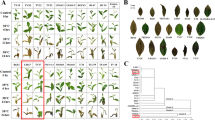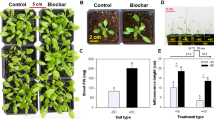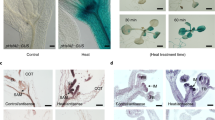Abstract
The role of inositol 1,4,5-trisphosphate (IP3) in transducing heat-shock (HS) signals was examined in Arabidopsis. The whole-plant IP3 level increased within 1 min of HS at 37 °C. After 3 min of HS, the IP3 level reached a maximum 2.5 fold increase. Using the transgenic Arabidopsis plants that have AtHsp18.2 promoter-β-glucuronidase (GUS) fusion gene, it was found that the level of GUS activity was up-regulated by the addition of caged IP3 at both non-HS and HS temperatures and was down-regulated by the phospholipase C (PLC) inhibitors {1-[6-((17β-3-Methoxyestra-1,3,5(10)-trien-17-yl)amino)hexyl]-2,5-pyrrolidinedione}(U-73122).
The intracellular-free calcium ion concentration ([Ca2+]i) increased during HS at 37 °C in suspension-cultured Arabidopsis cells expressing apoaequorin. Treatment with U-73122 prevented the increase of [Ca2+]i to some extent. Above results provided primary evidence for the possible involvement of IP3 in HS signal transduction in higher plants.
Similar content being viewed by others
Log in or create a free account to read this content
Gain free access to this article, as well as selected content from this journal and more on nature.com
or
References
Knight MR, Campbell AK, Smith SM, Trewavas AJ . Transgenic plant aequorin reports the effects of touch and cold shock and elicitors on cytoplasmic calcium. Nature 1991; 352:524–526.
Knight H, Trewavas AJ, Knight MR . Calcium signaling in Arabidopsis thaliana responding to drought and salinity. Plant J 1997; 12:1067–1078.
van der Luit AH, Olivari C, Haley A, Knight MR, Trewavas AJ . Distinct calcium signaling pathways regulate calmodulin gene expression in tobacco. Plant Physiol 1999; 121:705–714.
Sanders D, Pelloux J, Brownlee C, Harper JF . Calcium at the crossroads of signaling. Plant Cell 2002; 14 Suppl:S401–417.
Stevenson MA, Calderwood SK, Hahn GM . Rapid increases in inositol trisphosphate and intracellular Ca2+ after heat shock. Biochem and Biophys Res Commun 1986; 137:826–833.
Kiang JG, Koenig ML, Smallridge RC . Heat shock increases cytosolic free Ca2+concentration via Na+-Ca2+ exchange in human epidermoid A 431 cells. Am J Physiol 1992; 263:C30–38.
Gong M, ver dan Luit AH, Knight MR, Trewavas AJ . Heat-shock-induced changes in intracellular Ca2+ level in tobacco seedlings in relation to thermotolerance. Plant Physiol 1998; 116:429–437.
Mosser DD, Kotzbauer PT, Sarge KD, Morimoto RI . In vitro activation of heat shock transcription factor DNA-binding by calcium and biochemical conditions that affect protein conformation. Proc Natl Acad Sci USA 1990; 87:3748–3752.
Kiang JG, Carr FE, Burns MR, McClain DE . HSP-72 synthesis is promoted by increase in [Ca2+]i or activation of G proteins but not pHi or cAMP. Am J Physiol 1994; 265:C104–114.
Kiang JG, Tsokos GC . Heat shock protein 70 kDa: Molecular Biology, Biochemistry, and Physiology. Pharmacol Ther 1998; 80:183–201.
Kuznetsov VV, Andreev IM, Trofimova MS . The synthesis of HSPs in sugar beet suspension culture cells under hyperthermia exhibits differential sensitivity to calcium. Biochem Mol Biol Int 1998; 45:269–278.
Liu HT, Li B, Shang ZL et al. Calmodulin is involved in heat shock signal transduction in wheat. Plant Physiol 2003; 132:1186–1195
Li B, Liu HT, Sun DY, Zhou RG . Ca2+ and calmodulin modulate DNA-binding activity of maize heat shock transcription factor in vitro. Plant Cell Physiol 2004; 45:627–634.
Kiang JG, McClain DE . Effect of heat shock, [Ca2+]i, and cAMP on inositol triphosphate in human epidermoid A-431 cells. Am J Physiol 1993; 264:C1561–1569.
Sanders D, Brownlee C, Harper JF . Communicating with Calcium. Plant Cell 1999; 11:691–706.
Allen GJ, Muir SR, Sanders D . Release of Ca2+from individual plant vacuoles by both InsP3 and cyclic ADP-ribose. Science 1995; 268:735–737.
Wu Y, Kuzma J, Marechal E et al. Abscisic acid signaling through cyclic ADP-ribose in plants. Science 1997; 278:2126–2130.
Drobak BK . Plant phosphoinositides and intracellular signaling. Plant Physiol 1993; 102:705–709.
Yueh YG, Crain RC . Deflagellation of Chlamydomonas reinhardtii follows a rapid transitory accumulation of inositol 1,4,5-trisphosphate and requires Ca2+ entry. J Cell Biol 1993; 123:869–875.
Kim HY, Cote GG, Crain RC . Inositol 1,4,5-trisphosphate may mediate closure of K+channels by light and darkness in Samanea saman motor cells. Planta 1996; 198:279–287.
Drobak BK, Watkins PA . Inositol 1,4,5-trisphosphate production in plant cells: an early response to salinity and hyperosmotic stress. FEBS Lett 2000; 481:240–244.
Takahashi S, Katagiri T, Hirayama T, Yamaguchi-Shinozaki K, Shinozaki K . Hyperosmotic stress induces a rapid and transient increase in inositol 1,4,5-trisphosphate independent of abscisic acid in Arabidopsis cell culture. Plant Cell Physiol 2001; 42:214–222.
DeWald DB, Torabinejad J, Jones CA et al. Rapid accumulation of phosphatidylinositol 4,5-bisphosphate and inositol 1,4,5-trisphosphate correlates with calcium mobilization in salt-stressed Arabidopsis. Plant physiol 2001; 126:759–769.
Martinez-Estevez M, Racagni-Di PG, Munoz-Sanchez JA et al. Aluminium differentially modifies lipid metabolism from the phosphoinositide pathway in coffea arabica cells. J Plant Physiol 2003; 160:1297–1303.
Stevenson JM, Perera IY, Heilmann II, Persson S, Boss WF . Inositol signaling and plant growth. Trends Plant Sci 2000; 5:252–258.
Takahashi T, Naito S, Komeda Y . The Arabidopsis HSP18.2 promoter/GUS gene fusion in transgenic Arabidopsis plants: a powerful tool for the isolation of regulatory mutants of the heat-shock response. Plant J 1992; 2:751–761.
Jefferson RA, Kavanagh TA, Bevan MW . GUS fusions: β-glucuronidase as a sensitive and versatile gene marker in higher plants. EMBO J 1987; 6:3901–3907.
Mithöfer A, Mazars C . Aequorin-based measurements of intracellular Ca2+-signatures in plant cells. Biol Proc. Online 2002; 4:105–118.
Lee Y, Choi YB, Suh S et al. Abscisic acid-induced phosphoinositide turnover in guard cell protoplasts of Vicia faba. Plant physiol 1996; 110:987–996.
Sanchez JP, Chua NH . Arabidopsis PLC1 is required for secondary responses to abscisic acid signals. Plant Cell 2001; 13:1143–1154
Gilroy S, Read ND, Trewavas AJ . Elevation of cytoplamic calcium by caged calcium or caged Inositol trisphosphate initiates stomatal closure. Nature 1990; 346:769–771.
Calderwood SK, Stevenson MA, Price BD . Activation of phospholipase C by heat shock requires GTP analogs and is resistant to pertussis toxin. J Cell Physiol 1993; 156:153–159.
Liu HT, Sun DY, Zhou RG . Ca2+ and AtCaM3 are involved in the expression of heat shock protein gene in Arabidopsis. Plant Cell Environ 2005; 28:1276–1284.
Acknowledgements
We are grateful to Professor MR Knight (Department of Plant Sciences, University of Oxford, Oxford, UK) for the suspension-culture Arabidopsis cells expressing apoaequorin. We thank Dr Takahashi and Professor Yoshibumi Komeda (Molecular Genetics Research Laboratory, The University of Tokyo, Tokyo, Japan) for the transgenic Arabidopsis seeds. This work was supported by the National Natural Science Foundation of China (No. 30270796) and Natural Science Foundation of Hebei Province, China (No. C2005000171).
Author information
Authors and Affiliations
Corresponding authors
Rights and permissions
About this article
Cite this article
Liu, H., Gao, F., Cui, S. et al. Primary evidence for involvement of IP3 in heat-shock signal transduction in Arabidopsis. Cell Res 16, 394–400 (2006). https://doi.org/10.1038/sj.cr.7310051
Received:
Revised:
Accepted:
Published:
Issue date:
DOI: https://doi.org/10.1038/sj.cr.7310051
Keywords
This article is cited by
-
Recent advances in plant thermomemory
Plant Cell Reports (2021)
-
Heat stress in macrofungi: effects and response mechanisms
Applied Microbiology and Biotechnology (2021)
-
Phosphoinositide-specific phospholipase C gene involved in heat and drought tolerance in wheat (Triticum aestivum L.)
Genes & Genomics (2021)
-
Heterologous expression of heat stress-responsive AtPLC9 confers heat tolerance in transgenic rice
BMC Plant Biology (2020)
-
Identification of conserved and novel miRNAs responsive to heat stress in flowering Chinese cabbage using high-throughput sequencing
Scientific Reports (2019)



